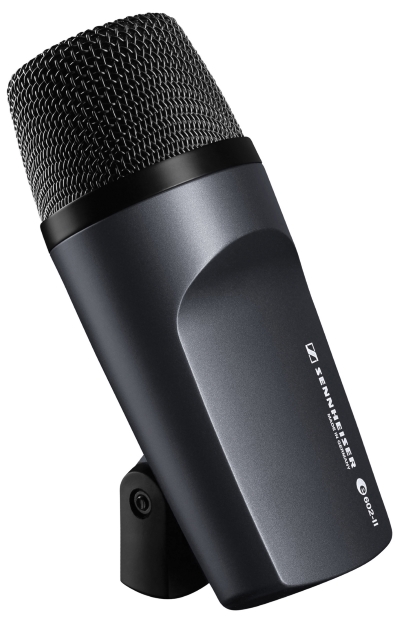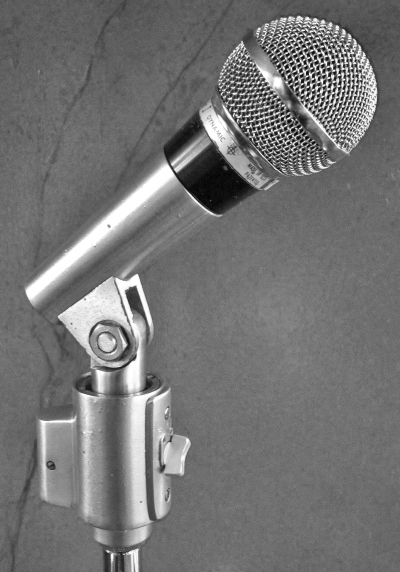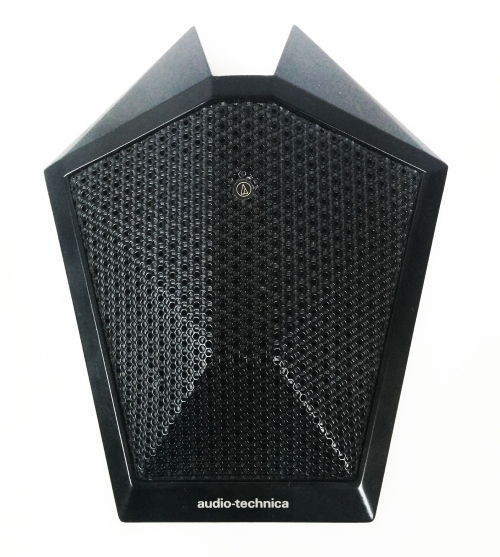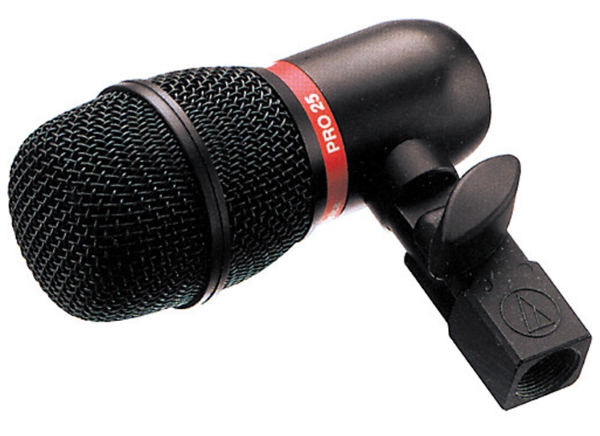There’s been steady progress in terms of microphone development, but another upside is that there are numerous models available that may be “old” (replaced by newer models and designs) that still have a lot to offer in live applications.
Mics such as the Shure SM58 (which turned 50 last year), Sennheiser MD421 and Electro-Voice RE20 may come immediately to mind (because they’re still going strong and are proliferate), but there are dozens (hundreds?) of other older models that are quite viable.
One of the best parts, to me, is that the vintage models are usually discounted when the later versions roll out, and in some cases, just a few years down the road many of these mics can be had for a song. Sometimes the “improvements” are purely cosmetic, and in other cases, upgrades might be limited to accessories or mounting options.
Several years ago, a manufacturer came out with a replacement of a model that was (and still is) a staple of my company’s inventory. The only change was the addition of a roll-off switch, which while practical and a nice addition, certainly didn’t make our models obsolete in the least.
 Sennheiser e 602
Sennheiser e 602While I’m constantly scouring pawn shops, estate sales, and auctions (live and online) for additions to my vintage mic collection, I also keep an eye out for older units to join our working inventory that perform well without breaking the budget.
With that in mind, here are some – well, let’s call them “mature” – models that are great additions to any mic locker. Also note that a lot of the photos are more recent versions of their predecessors, but in most cases, they’re almost identical in terms of appearance.
One of my favorites is the Sennheiser evolution series e 602, a cardioid dynamic optimized for low-frequency instruments and kick drum. It has a 20 Hz – 16 kHz frequency response that’s tailored with a boosted high (+8 dB from 2 kHz – 15 kHz) and low (+8 dB boost centered around 70 Hz) response.
A humbucking coil reduces EMI/RFI noise, and it has a built-in stand mount. The update is the e602-II that’s identical in appearance but offers a more aggressively sculpted EQ curve. It’s also a bit lighter in weight.
Looking for a good measurement mic? Try an Audix TR40.
Another excellent Audix legacy unit is the condenser SCX-25, replaced by the SCX-25A that offers a bit better lower frequency response. Both models, shaped like a lollipop, look really cool, and they use the same 5-micron thick, 25-mm wide single-diaphragm capsule. The original has a 20 Hz – 20 kHz frequency response and a 138 dB maximum SPL rating.
This omnidirectional model has a nice flat response from 20 Hz – 20 kHz and can handle a maximum SPL of 128 dB. Note the newer TR40A has higher self-noise (increased from 17 dBa to 28 dBa) lower maximum SPL handling (120 dB), and is less sensitive (sensitivity decreased from 17.9 mV/Pa to 12 mV/Pa).
The small size (the body is less than 4 inches long) makes for easy placement on a variety of acoustic instruments like guitars, bells, percussion, etc. It’s also a solid choice for choirs.
 Electro-Voice PL80
Electro-Voice PL80Electro-Voice has been around since 1927 (happy 90th anniversary!), with many older models that still have a place in any inventory. On my favorites list is the PL80, a dynamic vocal mic that’s really sharp looking, and with a rugged Memraflex grill that resists deformation.
A supercardioid type, it has a frequency response of 60 Hz – 17 kHz, and to my ear, sounds really good. We also have a few of the newer PL80a models in the inventory that sport the more traditional dark body/wire grill look.
 Electro-Voice ND468
Electro-Voice ND468EV was also the first manufacturer to incorporate neodymium magnet structures, first deployed in the N/DYM Series about three decades ago. Later came the ND Series, which has been recently revitalized with new models and technology (Road Test, LSI April 2017). Some of the older models are now discontinued and savvy folks can snatch them up at very attractive prices.
One of my favorite models is the ND468, which has a head supported by two arms that can be swiveled and positioned as needed.
Designed specifically for instruments, the compact size and swivel head allows numerous placement options while the supercardioid pattern helps reduce unwanted bleed from other stage sources. The ND468 has a frequency response of 30 Hz – 22 kHz and can handle high SPL, making it suitable for a wide range of instruments.
In developing industry-leading mics for 85-plus years, Shure also has more than a few gems that have been discontinued for upgraded models.
The 545D and 545SD Unidyne III look like early SM57s and are excellent instrument mics. They have a cartridge shock mount that keeps handling noise to a minimum and dual impedance settings of 150 ohms or “high.”
 Shure 545D
Shure 545DFrequency response is 50 Hz – 15 kHz. As with many manufacturers, the “S” models indicate an on/off switch. Most will probably prefer the “D” models because the original 545, 545S and 545PE sported a 4-pin male connector (equivalent to the Amphenol MC4M connector).
The 545L version had an attached cable, was a bit smaller at 5 1/8-inch in length (as opposed to 6 3/16-inch) length of the 545D (the same length as a modern SM57).
They were designed to mount to goosenecks and were often employed in paging applications.
The 546 versions have a vibration shock mount, one of my favorite features on older Shure mics that helps reduce noises transmitted up the mic stand.
The 547 is an upgraded version of the 546, adding an on/off switch to the shock mount and with the lower range of the frequency response extended down to 40 Hz (similar to a newer SM57). A more modern (but discontinued) version is the SM56, a shockmounted SM57. We’re lucky to have a bunch of them in the inventory.
Another older Shure mic that’s nice to have around is the 566 Unisphere I that has a ball-shaped windscreen similar to a modern SM58. I keep one handy for drummers who sing because the shorter length keeps the mic out of the way of their sticks and the shock mounting helps reduce thumps and noises.
 Shure 566 Unisphere I
Shure 566 Unisphere IYears ago, Shure produced the Beta Green Series, a lower cost option but delivering very good performance. All five models sported an on/off switch.
The dynamic BG 1.0 is a basic cardioid design, but switchable for low or high impedance, while all the other models are low impedance only. The BG 2.0 and BG 3.0 add a neodymium magnet for higher output along with an improved shock mount, while the BG4.0 model is a slim condenser useful for live or recording. It has an extended flat response and can operate from a battery or phantom power.
The BG 5.0, the flagship of the line, is a condenser with an extended frequency response tailored for vocals that can also use a battery or be powered by phantom power.
We have a pair of the BG 4.0 condensers and have used them in many recording situations. They sound good on guitars and other string instruments, and as overheads.
 Audio-Technica AT871R
Audio-Technica AT871RAmong the “secret weapons” in our locker are Audio-Technica AT871R boundary mics, deployed when an inconspicuous appearance is required. With a 120-degree cardioid pattern, 30 Hz – 20 kHz frequency response, and high SPL handling (130 dB maximum), it’s a great choice for stage lips or for closer applications like podiums/lecterns.
We handle a yearly meeting for a company where the technical director doesn’t want to see gooseneck mics in the camera shots but a back-up is needed in case a wireless system fails, so we deploy an AT871R on the podium. It performs so well that during the awards portion of the program, it’s our only mic for the honorees to use for their thank-you speeches.
The A-T Pro 25, a hypercardioid dynamic model designed for instruments, has been popular with musicians and sound companies for years because it’s both rugged and can handle high SPL.
While the 30 Hz – 12 kHz frequency response may seem limited, it performs very well on toms and snare, with the built in stand mount and compact size making for easy positioning. In fact, the entire Pro Series has always been – and continues to be – a very high value proposition.
AKG, which has been in the mic business since 1947, has generated great models that while now older, still deliver superb performance. I’m partial to the D190 partly because of the good looks with its cool sintered grill windscreen and partly because it’s just a great sounding mic.
 AKG D190
AKG D190The D190 was also available in “S” models that added a switch. The regular models have a frequency response of 30 Hz – 16 kHz, but beware of the “R” models that were designed for reporters and have a reduced low end frequency response of 150 Hz – 16 kHz. Also check the connector end before purchasing because the “C” models were available with a DIN connector on the mic body instead of XLR found on the “E” models.
Billed as being for instruments, we own a few of the E models and attain very good results with hand drums like conga and Djembe, as well as hand percussion. They also make for a solid (and distinct looking) vocal mic, with the sintered grill working well in eliminating pops and breath sounds.
 AKG D310
AKG D310Another older AKG gem is the D310, a dynamic cardioid vocal model with a smooth response from 60 Hz – 18 kHz. It was also available with a locking switch as the D310 S. A sibling is the D320 that offers a hypercardioid pattern and is equipped with frequency response switches.
Both models look similar and offer a grill system consisting of layers of mesh, foam, and an inner cage to protect the nicely shock mounted element. A buddy of mine has over a dozen D310s and they’re still his “go-to” for main vocals. We only have a few, but they’re regularly employed for vocals as well.
beyerdynamic was another early adopter of neodymium magnet structures, found in the TG-X 180. A handheld dynamic, it has a 40 Hz – 16 kHz frequency response and a hypercardioid pattern, sounding great on vocalists.
 beyerdynamic TG-X 58
beyerdynamic TG-X 58The company’s TG-X 48 and TG-X 58 are also solid, consistent performers. The factory states that these mics “were coated with a special soft lacquer coating which makes them very comfortable to hold in the hand.” Both offer a 50 Hz – 15 kHz frequency response and a supercardioid pattern, with TG-X 58 model sporting an on/off switch.
One of my favorites from beyerdynamic is the M420 dynamic designed for toms and snare. It looks like a small pencil condenser, with the compact size affording a wide range of positioning options.
The tailored frequency response of 100 Hz – 12 kHz was designed to help reduce bleed from kick drum, and the solid brass casing can take a beating, an especially valuable attribute when used on drum kits.
 beyerdynamic M420
beyerdynamic M420Finally, if you’re in the market for a good deal on a high-end ribbon mic, track down a Royer Labs SF-1. This compact model has low self-noise and no internal active electronics that can overload or produce distortion up to the maximum 130 dB SPL rating.
The SF-1 exhibits a natural flat response from 30 Hz – 15 kHz and is ideal for miking up everything on stage from delicate acoustic instruments to more aggressive instruments like brass sections and percussion. And a colleague swears by his SF-1s for drum overheads and area miking.




















